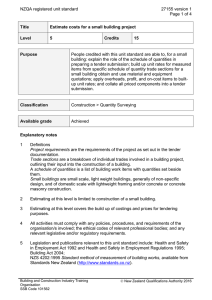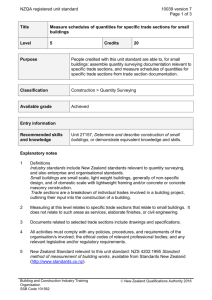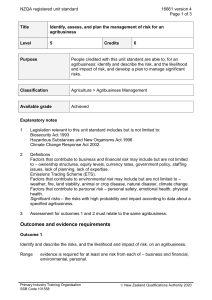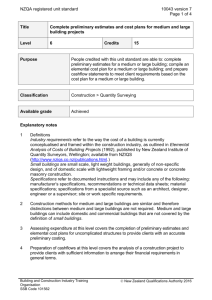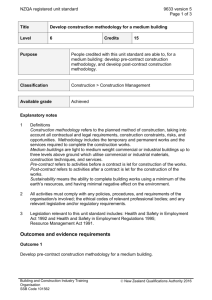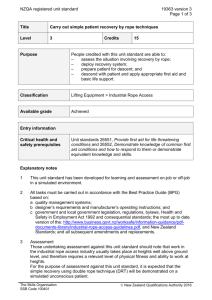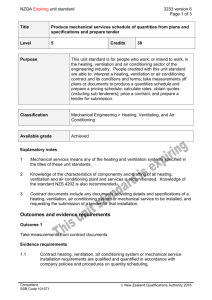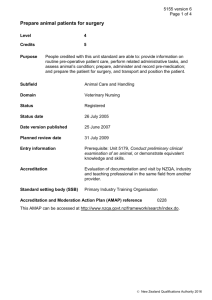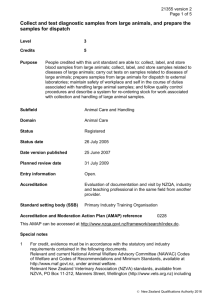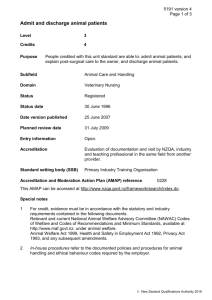27151 Estimate costs for medium or large building projects
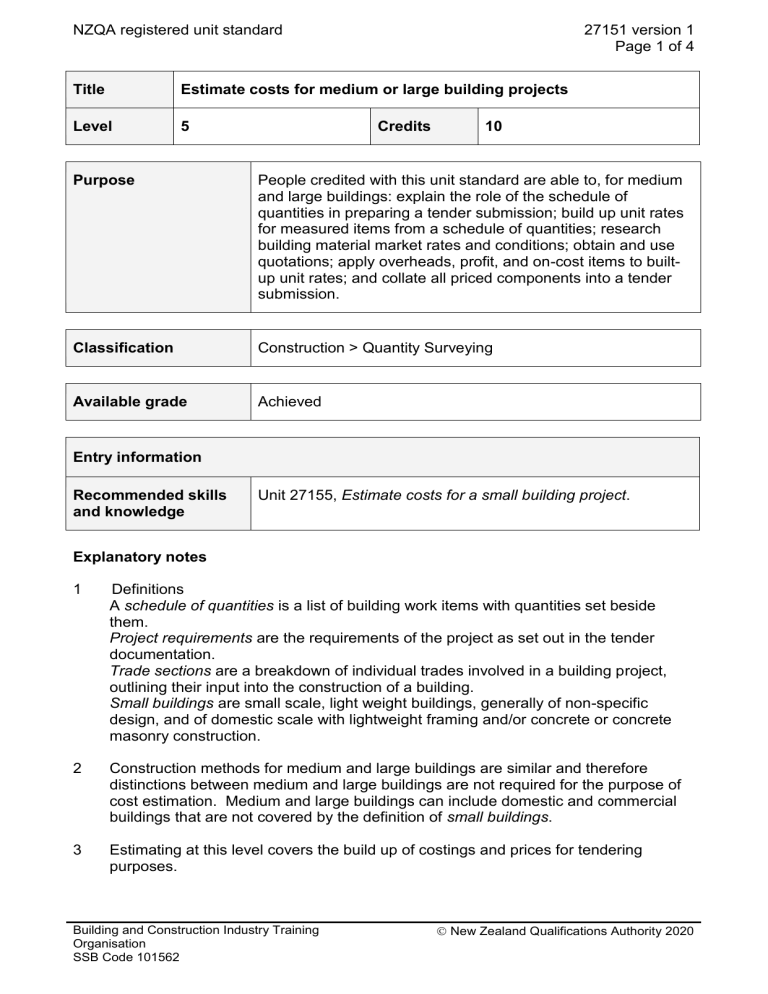
NZQA registered unit standard
Title
Level
Purpose
Estimate costs for medium or large building projects
5 Credits 10
27151 version 1
Page 1 of 4
People credited with this unit standard are able to, for medium and large buildings: explain the role of the schedule of quantities in preparing a tender submission; build up unit rates for measured items from a schedule of quantities; research building material market rates and conditions; obtain and use quotations; apply overheads, profit, and on-cost items to builtup unit rates; and collate all priced components into a tender submission.
Classification
Available grade
Entry information
Construction > Quantity Surveying
Achieved
Recommended skills and knowledge
Unit 27155, Estimate costs for a small building project .
Explanatory notes
1 Definitions
A schedule of quantities is a list of building work items with quantities set beside them.
Project requirements are the requirements of the project as set out in the tender documentation.
Trade sections are a breakdown of individual trades involved in a building project, outlining their input into the construction of a building.
Small buildings are small scale, light weight buildings, generally of non-specific design, and of domestic scale with lightweight framing and/or concrete or concrete masonry construction.
2 Construction methods for medium and large buildings are similar and therefore distinctions between medium and large buildings are not required for the purpose of cost estimation. Medium and large buildings can include domestic and commercial buildings that are not covered by the definition of small buildings .
3 Estimating at this level covers the build up of costings and prices for tendering purposes.
New Zealand Qualifications Authority 2020 Building and Construction Industry Training
Organisation
SSB Code 101562
NZQA registered unit standard 27151 version 1
Page 2 of 4
4 All activities must comply with any policies, procedures, and requirements of the organisation/s involved; the ethical codes of relevant professional bodies; and any relevant legislative and/or regulatory requirements.
5 Legislation and publications relevant to this unit standard include: Health and Safety
Act 1992 and Health and Safety in Employment Regulations 1995;
Building Act 2004;
NZS 4202:1995 Standard method of measurement of building works
Standards New Zealand ( http://www.standards.co.nz
).
, available from
Outcomes and evidence requirements
Outcome 1
Explain the role of the schedule of quantities in preparing a tender submission for medium or large building projects.
Evidence requirements
1.1 Trade sections of a schedule of quantities are explained in relation to main contractor and subcontractor costs and responsibilities.
1.2 The preliminary and general section of a schedule of quantities is explained in relation to main contractor and subcontractor costs and responsibilities.
Outcome 2
Build up unit rates for measured items from specific schedule of quantity trade sections for a medium or large building.
Range six of – preliminary and general work, demolition, excavation, underpinning, piling, concrete work, precast concrete, reinforcing steel, structural steel, mastic asphalting, stone masonry, metalwork, metal windows and doors, carpentry
(laminated timber), joinery, proprietary partitions, plumbing and gasfitting, drainage, solid plaster, tiling, terrazzo work, site works; one of
– mechanical services, fire protection, electrical services.
Evidence requirements
2.1 Measured items are separated into pricing components.
Range labour, materials, plant, on site overheads, off site overheads, profit.
2.2 Labour, materials, and related items are selected and applied to these components to build up unit rates.
New Zealand Qualifications Authority 2020 Building and Construction Industry Training
Organisation
SSB Code 101562
3.2
3.3
NZQA registered unit standard 27151 version 1
Page 3 of 4
Outcome 3
Obtain and use material and equipment quotations for a medium or large building.
Evidence requirements
3.1 Market rates of materials and equipment are investigated in terms of cost, availability, and conditions of sale or hire.
Quotations are obtained from suppliers.
Quotations are assessed against, and selected to meet, project requirements.
Outcome 4
Apply overheads, profit, and on-cost items to built-up unit rates for a medium or large building.
Evidence requirements
4.1 The principles of overheads, profit requirements, and on-cost items are classified and explained in terms of total trade costs.
4.2 These principles are used in the formation of built-up unit rates.
Outcome 5
Collate all priced components into a tender submission for a medium or large building.
Evidence requirements
5.1 Priced items and trade totals are collated to contribute to a tender submission in accordance with tender and contract conditions.
Replacement information This unit standard replaced unit standard 10041.
Planned review date 31 December 2015
Status information and last date for assessment for superseded versions
Process Version Date Last Date for Assessment
Registration 1 18 March 2011 N/A
Accreditation and Moderation Action Plan (AMAP) reference 0048
This AMAP can be accessed at http://www.nzqa.govt.nz/framework/search/index.do
.
New Zealand Qualifications Authority 2020 Building and Construction Industry Training
Organisation
SSB Code 101562
NZQA registered unit standard 27151 version 1
Page 4 of 4
Please note
Providers must be granted consent to assess against standards (accredited) by NZQA, or an inter-institutional body with delegated authority for quality assurance, before they can report credits from assessment against unit standards or deliver courses of study leading to that assessment.
Industry Training Organisations must be granted consent to assess against standards by
NZQA before they can register credits from assessment against unit standards.
Providers and Industry Training Organisations, which have been granted consent and which are assessing against unit standards must engage with the moderation system that applies to those standards.
Consent requirements and an outline of the moderation system that applies to this standard are outlined in the Accreditation and Moderation Action Plan (AMAP). The
AMAP also includes useful information about special requirements for organisations wishing to develop education and training programmes, such as minimum qualifications for tutors and assessors, and special resource requirements.
Comments on this unit standard
Please contact the Building and Construction Industry Training Organisation national.office@bcito.org.nz
if you wish to suggest changes to the content of this unit standard.
Building and Construction Industry Training
Organisation
SSB Code 101562
New Zealand Qualifications Authority 2020
